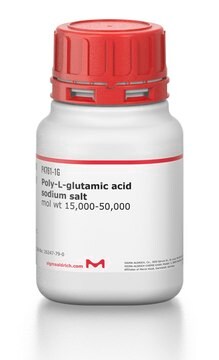P3418
Poly-(α,β)-DL-aspartic acid sodium salt
mol wt 2,000-11,000
Synonyme(s) :
Aspartic acid homopolymer sodium salt
About This Item
Produits recommandés
Forme
powder
Niveau de qualité
Poids mol.
2,000-11,000
Couleur
white to off-white
Température de stockage
−20°C
Vous recherchez des produits similaires ? Visite Guide de comparaison des produits
Catégories apparentées
Application
- Improving the effectiveness of (-)-epigallocatechin gallate (EGCG) against rabbit atherosclerosis by EGCG-loaded nanoparticles prepared from chitosan and polyaspartic acid.: This research highlights the development of nanoparticles using polyaspartic acid to enhance the bioavailability and therapeutic effect of EGCG in treating atherosclerosis (Hong et al., 2014).
- Polyaspartate, a biodegradable chelant that improves the phytoremediation potential of poplar in a highly metal-contaminated agricultural soil.: The study evaluates the use of polyaspartate in enhancing the phytoremediation capabilities of poplar trees, showcasing its environmental application for soil decontamination (Lingua et al., 2014).
- Modulation of calcium oxalate dihydrate growth by selective crystal-face binding of phosphorylated osteopontin and polyaspartate peptide showing occlusion by sectoral (compositional) zoning.: This research investigates the role of polyaspartate in modulating the growth of calcium oxalate crystals, with implications for understanding kidney stone formation (Chien et al., 2009).
Notes préparatoires
Remarque sur l'analyse
Autres remarques
Code de la classe de stockage
11 - Combustible Solids
Classe de danger pour l'eau (WGK)
WGK 3
Point d'éclair (°F)
Not applicable
Point d'éclair (°C)
Not applicable
Certificats d'analyse (COA)
Recherchez un Certificats d'analyse (COA) en saisissant le numéro de lot du produit. Les numéros de lot figurent sur l'étiquette du produit après les mots "Lot" ou "Batch".
Déjà en possession de ce produit ?
Retrouvez la documentation relative aux produits que vous avez récemment achetés dans la Bibliothèque de documents.
Articles
Humankind has utilized protein materials throughout its existence, starting with the use of materials such as wool and silk for warmth and protection from the elements and continuing with the use of recombinant DNA techniques to synthesize proteins with unique and useful properties.
Notre équipe de scientifiques dispose d'une expérience dans tous les secteurs de la recherche, notamment en sciences de la vie, science des matériaux, synthèse chimique, chromatographie, analyse et dans de nombreux autres domaines..
Contacter notre Service technique







